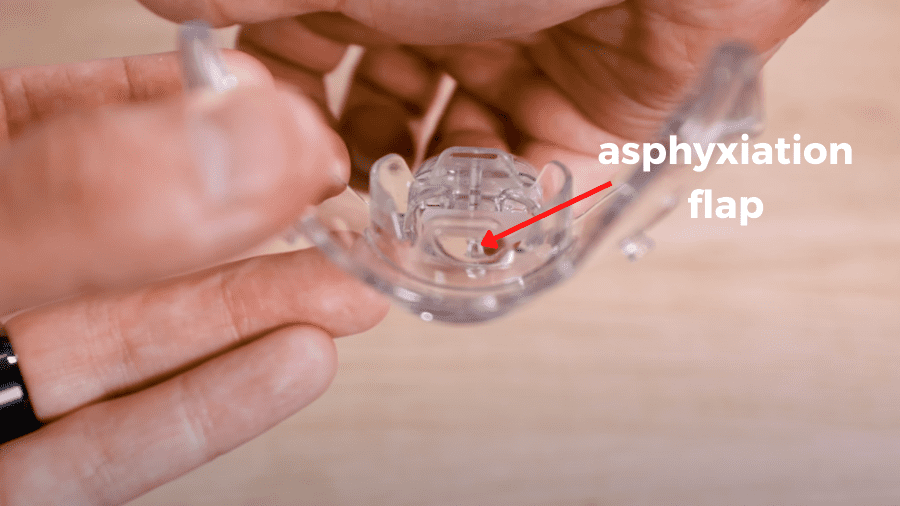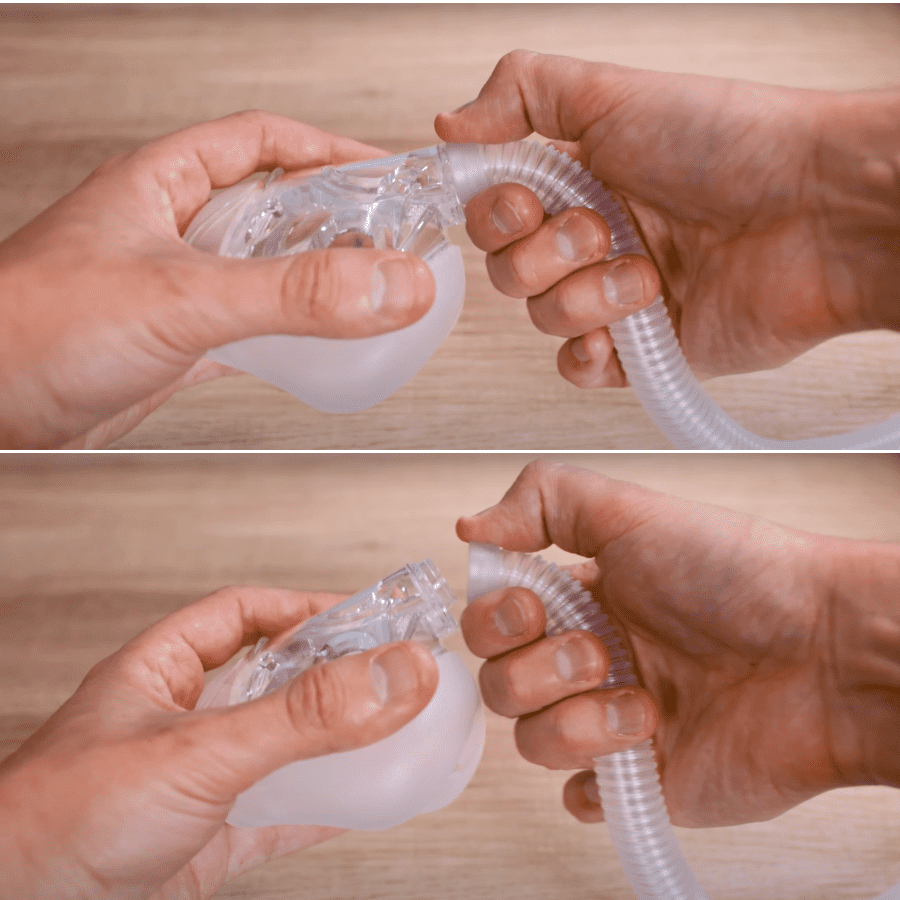Today we are taking a closer look at the Evora full face mask from Fisher & Paykel. This mask has been really well thought out – from the overall user experience down to the nitty-gritty details. This mask is impressive.
So let’s check it out. And the easiest way to do this is to start at the back of the mask and work our way forward. So let’s take a look at the straps first.
Evora Mask Straps
The straps themselves are pretty standard, nothing too groundbreaking here. The Velcro – though they are not really Velcro – are the same Fisher and Paykel design that doesn’t pick up hairs or debris or lose their stickiness over time.

And there’s a small overhanging end to the straps after the Velcro that is easy to grab to make taking off the mask easy.
Where the straps intersect on the back, there is a nice stretchable, cushioned meshed fabric, which Fisher and Paykel refer to as VentiCool™ technology.

This is designed to be breathable and let heat and moisture escape from your head so you stay more cool and more comfortable during the night.
If you’re familiar with the Vitera mask, it is the same technology as what Fisher and Paykel used on that headgear, as well.
Once you have your mask straps fitted as you like them, adjust the top straps first to get the top of the mask frame stable on the base of your nose, and then tighten the bottom straps as needed to get a good seal.

Remember not to over-tighten, and once you think you’re happy with the strap fit, make sure to run a Mask Fit test on your CPAP device. Getting a good mask seal is very important. Otherwise, air will leak during use, which will result in loss of pressure and an uncomfortable and noisy night’s sleep.
And with the Evora mask, once you have that perfect fit, the beauty of it is that there really is no need to fit it again. The straps attach to the mask frame with nice, strong clips which allow you to take off or put on the mask without needing to touch the Velcro on the straps.

And when you need to fully disassemble the headgear for cleaning, simply remove the clips and also the two pins at the top of the mask frame, and the straps remove entirely.
You can even clean your straps with the Velcro still in place if you wanted, so there really would be no occasion to have to refit yourself.
Evora Mask Cushion
Next up is the cushion. To remove the cushion from the mask frame, push in where the strap clips attach to the cushion and pull the cushion out by grabbing onto the more rigid silicone near its center.

Be sure not to pull the cushion away by grabbing onto the outer edge of the silicone, or it could tear over time.
There are three size options of cushions on the Evora:
- Extra small
- Small / Medium
- Large.
If you go into your DME personally to buy the mask, then chances are you’ll be fitted by a professional and receive the correct size cushion for you.
But if you are purchasing this mask online – like on respshop.com – then it’s typically a good idea to buy the Fit Pack, which includes all three cushions for you to fit and test yourself at home, until you settle on the size that works best for you.

When you order from Respshop, please make sure to choose either your size or the Fit Pack from the dropdown menu.
No matter what size you are, the footprint of the cushion is the same. The only thing that changes as you go through the sizes is the nasal cutout size – everything else about its shape remains the same.
And speaking of its shape, you’ll notice that it’s quite shallow and compact, resulting in it sitting close to your face.

This low-profile design has a couple of advantages. It helps with mask stability and opens up your field of view while wearing the mask.
This means that it doesn’t encroach on your vision in the same way that a larger full-face mask would, which helps the experience of wearing a mask feel a little less claustrophobic, especially for those new to CPAP therapy.
The cushion sits beneath the nose, and no part of the mask touches the bridge of your nose, allowing the user to wear glasses while using the mask. So, if you’re someone who likes to do some reading or watch TV as you fall asleep, that could be a nice feature for you.
Evora Mask Frame
Ok, now onto the mask frame. You’ll notice that the frame has a unique shape with stable wings creating the pronounced U shape in the frame.

The stability wings help to keep the mask in place while you naturally move around at night.
Again, the whole design of the Evora is all about being compact while not compromising functionality. And the mask does feel stable while still being so light – it’s quite impressive.
The positioning of the vents on the frame throws air during exhalation down and out, so if you’re reading a book or are using your phone, it’s not going to bother you much.
Connected to your mask frame is, of course, the mask tubing. You’ll notice at the connection point there is a small internal flap.

Make sure to clean this asphyxiation flap thoroughly when you clean your mask and ensure that it dries well.
Improper cleaning of the flap over a prolonged period will cause grime to build up will affect the mask’s performance and may even cause it to smell.
The other thing you’ll notice about the tubing is that it is pointed directly downwards from the mask frame, which continues the low side profile of the headgear.

Again, this is just to keep the mask streamlined and less bulky to increase your comfort and enjoyment of the product.
To remove the tubing from the mask frame, squeeze at the attachment point and pull away like you are opening a soda can tab. Do not pull the tube itself lower down or it will stretch and ruin.

Again, make sure you do this opening motion; if you pull directly away, it can be very difficult.
And lastly, to remove the swivel piece from the tubing, simply squeeze as you pull away – and there you go! Your Evora mask is now fully disassembled and ready to be cleaned.

You’ll want to do the cleaning every week for the whole headgear, and every couple of days or so just for the cushion. A clean, grease-free mask forms a better seal on your head, which in turn means fewer air leaks.
To clean the mask, whether it’s the cushion or any other part, use a mild dishwashing detergent in warm water – and non-toxic detergent is best. Gently wash each piece separately and then rinse with clean water and leave on a towel to dry, out of direct sunlight.
Don’t forget – even with proper care, you may well still need to replace parts of your mask every 12 months or so, so it’s a good practice to take a quick look over the various parts during your weekly cleaning.
Look for any cracks in the plastic or tears in the silicone and order what you need – Respshop.com has you covered for everything CPAP, including parts for your mask and other equipment.
Closing Thoughts
Well, that about wraps up this review for us. You can probably tell that the Evora full-face mask from Fisher and Paykel is a really well-thought-out mask that combines pleasing aesthetics, a compact design, and a great deal of attention to detail.
These attributes make using this mask as much of a pleasure as can be expected from having something that covers your nose and mouth while you sleep!
If you are looking to change masks, or perhaps you are new to CPAP sleep therapy and are someone who typically sleeps with their mouth open, then we’d have no hesitation in recommending the Evora to you.
Respshop.com is one of the biggest online distributors of CPAP equipment, so if you haven’t purchased from us in the past, be sure to give us a go and leave a review or comment below to let others know how it went.
That’s it for us; feel free to chat with one of our experts about the Evora or any other CPAP gear by giving us a call or visiting our site, and wherever you are… sleep tight!






